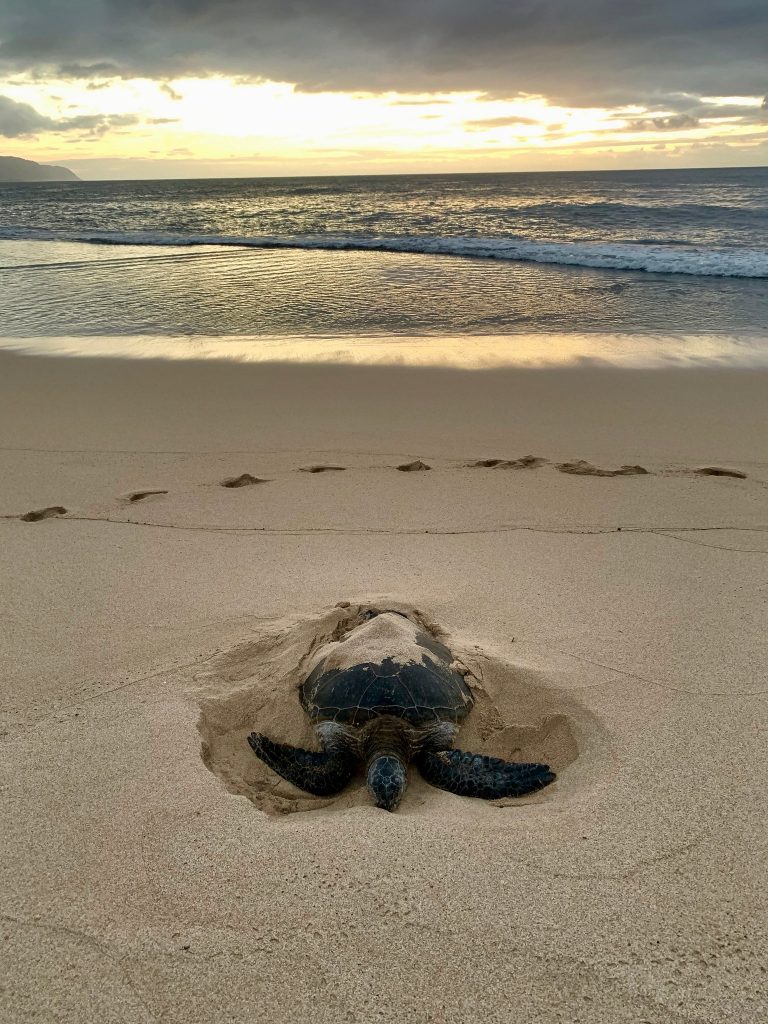Sea Turtle Nesting Season is Underway in Hawai‘i

Conservation groups are seeking the public’s help to protect sea turtles as their summer nesting season gets underway.
Statewide there are nearly 100 green sea turtle nests, plus an additional 44 hawksbill sea turtle nests. All are protected under the US Federal Endangered Species Act.
The US Fish and Wildlife Service, NOAA Fisheries, and Hawai‘i Department of Land and Natural Resources Division of Aquatic Resources are asking the public to help honu (green sea turtles) and honu‘ea (hawksbill sea turtles) by keeping a respectful distance from them and their nests.
The public is reminded to stay at least 10 feet away; avoid shining bright lights after dusk; and should not touch, feed or chase them. Harassing or disrupting a sea turtle or their nest can incur significant penalties, including fines of up to $100,000 and imprisonment of up to one year.

The nesting season continues through early September.
To report any suspected nesting activities, call NOAA at 1-888-256-9840 or email [email protected].
“The unprecedented level of nesting activity last year took everyone by surprise,” said Dr. Sheldon Plentovich, USFWS coastal program coordinator. “Since 2016 we have worked with community volunteers to locate and monitor sea turtle nests. Between 2016 and 2019 we never observed more than 10 nests on O‘ahu, so finding 58 in 2020 was very exciting for our team and the local community.”
The honu‘ea nests primarily on the islands of Hawai‘i, Maui, and Moloka‘i, while honu are known to use beaches state-wide. In Hawai‘i, sea turtles typically lay their nest at night near or under coastal vegetation well above the high tide line. In contrast, basking turtles are usually found closer to the water both during the day and at night. They like to flip sand with their front flippers when basking, but digging with their rear flippers might be an indicator of nesting activity.
According to the US Fish and Wildlife Service, mature honu females nest about every 4 years, laying approximately four clutches (nests), with each clutch containing about 100 eggs. Adult honu can grow up to 4 feet in length and weigh up to 400 pounds. Mature ‘ea females will nest every 2 to 8+ years, laying approximately six clutches, each of which contains about 180 eggs. Adult ‘ea can have a shell length of up to 3 feet and weigh up to 250 pounds. Only 20 to 25 hawksbill females nest each year in Hawai‘i; in contrast, 500 to 800 Hawaiian green turtles nest annually.
The agency says hatchlings typically emerge from their nest at night and find the ocean by crawling towards the brighter, open horizon. They ride ocean currents, feeding and growing for approximately 6 years, until they’re about 14 inches in length. At this age and size, they return to settle in the nearshore coral reef habitats of Hawai‘i. It’s in these reef habitats that turtles will feed and grow until they reach sexual maturity at 20 to 35 years of age. Turtles then undertake their first reproductive migration, returning to the same geographic location where they originally hatched, to nest and produce the next generation of sea turtles.
Members of the public interested in volunteering during this upcoming nestingseason to help survey beaches for nesting activity may send an email of interest to [email protected].




















